| 日本産業革命の地 | Site of Japan's Industrial Revolution | ||
| 横須賀から現代の生活につながっているもの 時間労働 日曜休日制 月給制 年功給・技能給 複式簿記 労務管理 健康管理 メートル法 産業革命とは蒸気機関で生産するだけでなく、それに伴って生活自体に変革を伴うもの。 横須賀造船所はまさに日本に産業革命をもたらしたと言える |
The following are some of the systems used at the Yokosuka Shipyard that are still used in our daily lives today. Hourly work system, Sunday holiday system, Monthly salary system, Seniority pay and skill pay, Double-entry bookkeeping, Labor management, Health care and Metric system The Industrial Revolution was not only about production with steam engines, but also about the accompanying changes in life itself. The Yokosuka Shipyard can be said to have truly brought the Industrial Revolution to Japan. |
||
| |
|||
横須賀製鉄所(造船所) 三つの特徴 |
Yokosuka Ironworks (Shipyard) Three Characteristics |
||
| 横須賀造船所(明治四年まで製鉄所と言った)の特徴として次の三つをあげておこう | We list the following three characteristics of the Yokosuka Shipyard (called the Ironworks until 1871). | ||
| 1. 何でも造る総合工場 だった 2. 慶応年間から蒸気機関による工業生産 をしていた 3. 教育機関で人づくり をしていた 以上を総合して考えると、横須賀製鉄所は日本産業革命の地と言えよう。 *工業史を研究している学者がこのことをなぜ言わないのか、不思議である。米軍基地内だから世界遺産にできないという言い訳はいらない。世界遺産になろうがなるまいが「日本産業革命の地」であることは変わらない。 |
1.
It was a general factory that built everything.
* A strange thing is that most scholars who study industrial history do not mention this fact. There is no need for the excuse that the site cannot be made a World Heritage site because it is on a US military base. Whether it becomes a World Heritage site or not, the fact that it is the "Site of Japan's Industrial Revolution" will not change. |
||
| 1,何でも造る総合工場 | 1. A comprehensive factory that builds everything | ||
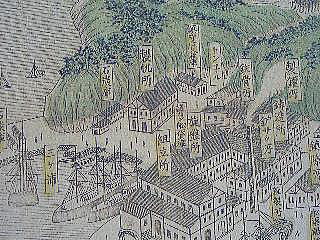 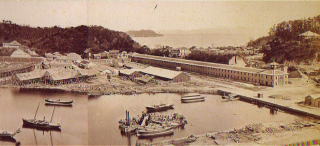 ▲製帆所・鉄工所 Sailmakers and ironworks ▲製綱所 Rope mills |
|||
| 造船所は船だけ造るところではない、以下のように何でも造らなければ船は完成しない。造船所とは「船も」造る所だった。 |
A shipyard is not only a place where ships are built, but also a place
where everything must be built to complete a ship, as shown below. |
||
| 横須賀製鉄所では蒸気機関、大炮、銃、砲弾や弾丸、鍋・釜・スプーンフォークからドアノブまであらゆる鉄製品のほか、船を造るためのたくさんの工業製品を造っていた。 例えば:、製帆所ー蒸気船が主流になりつつある幕末だが、蒸気船でもふだんは石炭を節約して風で航海していた(機帆船という)から、製帆所で帆布を織って、切って、縫って、帆を製作していた。 例えば、製綱所ー帆を開いたり閉じたりするロープを製綱所で造っていた。右の写真の長い建物が製綱所(ロープ工場)である。 例えば木工所ー当時は黒船といっても船体は木造だったから、構内の木工所で材木をアク抜きし、乾かして加工し船体、船室、床、天井、壁、階段などすべて木で作っていた。 もちろん鉄工所が構内の主流だった。蒸気機関を造るだけでなく、構造・機能・効率が研究され、船体工学と合わせて船舶工学が当時最高の工学の位置を占めていた。 ほかにネジはもちろん、あらゆる工具・部品・工業製品をここで造って「船も造った」から、造船所の周辺に下請け工場がない。下請けできる技術を持った民間業者がいないし、下請けに出す必要がなかったのだ。明治後年になると民間のロープ会社のロープで間に合うようになって明治21年に製綱所が稼働停止するなど、民間業者が発達していった。 以上の作業の原動力はすべて蒸気機関を用いていた。 |
At the Yokosuka Ironworks, they were producing many industrial products
used to build ships, including iron products such as steam engines, guns,
cannons, shells and bullets, pots, kettles, spoon forks, and doorknobs. For example, see the sailmaker's shop. At the end of the Edo period, steamships were becoming the mainstream, but even steamships usually sailed on the wind to save coal (called "motor sailing ships"), so sailcloth was woven, cut, and sewn at the sailmaker's shop to make sails. For example, see the rope mill. The mill was producing the ropes that opened and closed the sails. The long building in the photo on the left is a rope factory. For example, see the wood shop. Even though the Black Ships were wooden, the hulls of the ships were made of wood, so the wood shop on the premises was where the wood was de-axed, dried, and processed to make the hulls, cabins, floors, ceilings, walls, and stairs. Of course, the ironworks was the central player in the yard. In addition to building steam engines, the structure, the function, and the efficiency were studied, and together with hull engineering, naval engineering occupied the highest position in engineering at that time in Japan. In addition to screws, all kinds of tools, parts, and industrial products were made here, and ships were also built here, so there were no subcontracting factories around the shipyard. There were no private companies with the technology to do so, but there was no need to subcontract in the first place. In the later years of the Meiji era, they were able to make do with ropes produced by private rope companies, and the rope mills stopped operating in 1888, and private contractors developed. All of the above operations were powered by steam engines. |
||
| 2,慶応年間から 蒸気機関による工業生産 |
2. Industrial production using steam engines beginning in the Keio era | ||
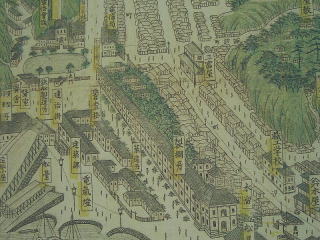 ▲製綱所(ロープ工場) どの工場も工場ごとの小型の蒸気機関で生産をしていた。ここが日本最初の近代ロープ製造の地である。 ▲ The Rope Factory: Each factory used its own small steam engine for production. This was the site of Japan's first modern rope production. |
|||
| 慶応元年1865に横須賀製鉄所の建設が始まった。構内のどの工場も完成すればすぐにそれぞれの蒸気機関を稼働して部品の生産を行ったから、慶応年間にはたくさんの工場が生産体制に入っている。 従来の日本の工業の原動力は、人力ー牛馬ー水車の力までだった。横須賀には大きな川がないから水力をアテにしていない、造船所ははじめから蒸気機関を原動力として設計されていたので「蒸気機関を原動力とする日本最初の総合工場」と言える。司馬遼太郎が「かつてここは日本の近代工学のいっさいの源泉であった」(「三浦半島記」)と書くゆえんである。 学校で「蒸気機関の使用から産業革命が始まった」と教えながら、横須賀製鉄所の史実を無視して教科書で「日本近代化の例」として富岡製糸場から教えているのは不思議でならない。 ◆2015平成27年に「明治日本の産業革命遺産ー製鉄・鉄鋼・造船・石炭産業ー」として世界遺産となった施設を見ると、蒸気機関の使用は小菅修船場跡1868明治元年だけで、その他の蒸気機関を用いている施設はほとんどが明治30~40年代。その他は原動力が水力であり、大阪山たたら製鉄遺跡(山口県萩市)のごとき足踏みフイゴを原動力とする施設さえ入っている。「努力遺産」としては認められようがこの程度のものがどうして産業革命遺産に入るのだろう。 |
Construction of the Yokosuka Ironworks began in 1865, the first year of Keio. As soon as the construction was completed, all the factories in Yokosuka started operating their own steam engines to produce various parts, and many factories began production during the Keio period. In the past, the driving force of Japanese industry had been human power, oxen and horses, and even water mills. Yokosuka does not have a large river, so it did not rely on water power. The shipyard was designed from the beginning to be powered by steam engines, so it can be called "Japan's first comprehensive factory powered by steam engines. That is why Ryotaro Shiba wrote, "This was once the source of all modern engineering in Japan" ("Miura Peninsula Chronicles"). It is quite surprising that schools in Japan teach that the Industrial Revolution began with the use of steam engines, but ignore the historical facts of the Yokosuka Ironworks and start with the Tomioka Silk Mill as an example of Japanese modernization in school textbooks. ◆ Looking at the facilities that were designated as World Heritage Sites in 2015 as "Industrial Revolution Heritage of Meiji Japan: Iron and Steel, Shipbuilding, and Coal Industries," the only facility that uses steam engines is the Kosuge Shusenjo site in 1868, the first year of the Meiji era, and most of the other facilities that used steam engines were built in the 1890s and 1940s. The rest of the facilities were powered by hydropower, including the Osakayama Tatara Ironworks site (Hagi City, Yamaguchi Prefecture), which was powered by a foot-operated funnel. It may be recognized as a "Heritage of Effort," but how can something of this level be included in the Industrial Revolution Heritage? |
||
| 3,教育機関で人づくり | 3. Human resource development in educational institutions | ||
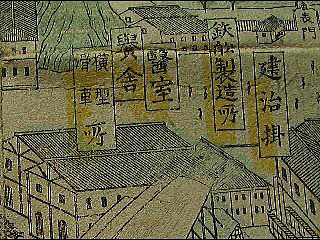 黌舎 Kosha School |
|||
| モノづくりの原点は人づくり。正確な作業が継続して行われることが必要である。横須賀には慶応年間から職工・技師を育てる学校「黌舎」が設置され、明治初年には更に高度な造船工学を学ぶ「海軍機関学校」が設けられた。 フランス人技師長ヴェルニーがいずれ日本人だけで運営できるよう計らった措置が基点となっている。誠意と熱意を持って製鉄所建設にあたったフランス人たちの志の高さが最も感じられる施設がこの黌舎と機関学校であろう。結果論になるが、フランスに建設指導を仰いだことは正解だった。 ちなみに、生野銀山の近代化を指導したフランス人技師コワニエも生野に鉱山学校を開設して若者の育成を図っている。 |
The starting point of manufacturing is human resource development. It
is necessary for accurate work to be performed continuously. In Yokosuka,
Kosha School for training craftsmen and engineers was established during
the Keio period (1865-1868), and in the first year of the Meiji period
(1868-1912), a "Naval Engineering School" was established to
study even more advanced shipbuilding engineering. It was based on the measures taken by the French chief engineer, Verney, to ensure that the plant could eventually be operated by only Japanese. The school building and the engine school are probably the facilities where the high aspirations of the French people who worked with sincerity and enthusiasm to build the ironworks can be felt the most. As a result, it was a good decision to ask the French for construction guidance. Incidentally, Jean-François Coignet, the French engineer who guided the modernization of the Ikuno Silver Mine, also opened a mining school in Ikuno to train young people. |
||
| 黌舎 「黌舎・こうしゃ」と呼ばれる職工学校を設け優秀な職工や技師を育てて現場に送った。慶応2年開校で授業料は無料、小遣いまで支給された。初めは近在農漁村の子弟中心だったが、卒業すれば間違いなく造船所で雇ってもらえ、家族を養えるほどの給料をもらえることから人気が高まり、全国から優秀な若者が殺到するようになった。後にはここに入るための予備校までできたという。 定員60名。フランス語、数学、物理、船舶工学を学び大学理工学部または高等工業専門学校卒業程度の知識と技術を身に着けた若者が、優秀な職工や技術者となって巣立っていった。高等技術者と職工を同じ場所で育成したのは珍しい方式といわれる。 例えば辰巳一少年は石川県金沢から歩いて横須賀の黌舎に入学、努力の末フランスに留学派遣されるまでの力をつけ後に造船大監となった。 すべての建設作業、製造作業がフランス式にメートル法で行われ、日本人がそれに慣れていったことは、画期的なことと言えよう。 |
Kosha School A school for artisans called the "Kosha School" was established to train excellent artisans and engineers and send them to the field. The school opened in 1866, the 2nd year of Keio, and tuition was free, and even an allowance was provided. At first, most of the students were from nearby farming and fishing villages, but once they graduated, they were sure to be hired by the shipyard and earn enough to support their families, so the popularity of the program grew and talented young people from all over the country began to pour in. It is said that a preparatory school was even established to prepare students to enter the school. The school had a capacity of 60 students. Young people who had studied French, mathematics, physics, and naval engineering, and had acquired knowledge and skills equivalent to those of graduates of university science and engineering schools or technical colleges, left the school to become excellent craftsmen and engineers. It is said to be a rare method to train both engineers and technicians in the same place. For example, one boy, Hajime Tatsumi, walked from Kanazawa in Ishikawa Prefecture to Yokosuka to enter Kosha School , and after much effort, he was able to study in France and later became a general superinntendent for shipbuilding. The fact that all construction and manufacturing work was done in the French metric system, and that the Japanese people became accustomed to it, was an epoch-making event. |
||
機関学校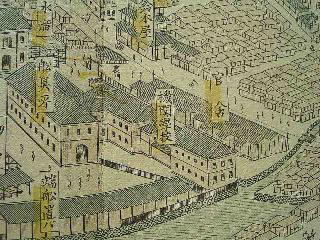 Engineering School Engineering School |
|||
機関学校 黌舎より上級クラスの学校として「機関学校」を設けて船の設計もできる幹部養成を図った。 明治初年に開校。やはり授業料は無料、小遣いまでもらえたので、全国から優秀な若者が集まり、最高の船舶工学を学び船の設計までできる技術将校が育成された。 東京大学工学部学生はここで学んで現場実習をしないと卒業単位が認められなかった。 芥川龍之介はここで英語を教えた。中島知久平(群馬県尾島村)はこの機関学校を卒業して海軍技術将校となり、のちに中島飛行機(戦後の財閥解体で、いまスバル自動車・群馬県太田市や、マキタ・沼津市など)を興した。 |
Engineering School |
||
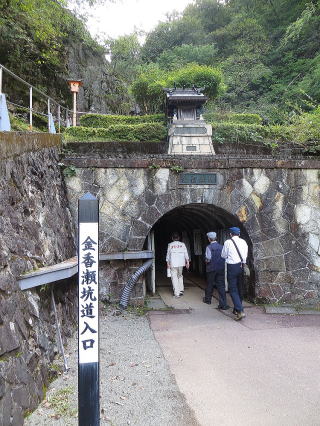 生野銀山 Ikuno Ginzan (sivler mine) |
|||
|
モデル鉱山 生野銀山は横須賀製鉄所の義弟 明治政府は、明治元年10月官営鉱山としてフランス人技師フランソワ・コワニエを招請、生野銀山(兵庫県朝来市)に新技術導入による経営改善を図り、製鉱所(精錬所)を建設。
コワニエは採掘用機械・鉱石処理用の溶鉱炉などの諸設備の製作・輸入を横須賀製鉄所に発注、機械や鉱山用の照明ランプなどを自ら設計もした。その他蒸気機関や大小800種類もの器具が横須賀製鉄所で製作され、製作できないものは横須賀製鉄所を経由してフランスから輸入された。
横須賀製鉄所から購入した蒸気機関や機械類によりエレベータや輸送用の馬車道を整備するなど日本の近代化鉱業のモデル鉱山となって、技師や熟練鉱夫が全国の鉱山に派遣され、日本中の鉱山に普及していった。 |
The model mine Ikuno Ginzan (sivler mine) is the brother-in-law of Yokosuka Ironworks In October of the first year of the Meiji era (1868-1912), the Meiji government invited French engineer, Francois Coignet, to work at the Ikuno Silver Mine (Asago City, Hyogo Prefecture) as a government-owned mine, and built a smelter to improve management by introducing new technology. Coignet ordered the Yokosuka Ironworks to manufacture and import various equipment such as mining machinery and blast furnaces for ore processing, and designed the machinery and lighting lamps for the mine himself. In addition, the Yokosuka Works manufactured steam engines and 800 types of equipment of various sizes, and those that could not be manufactured were imported from France via the Yokosuka Works. The steam engines and machinery purchased from the Yokosuka Works were used to build elevators and carriage roads for transportation, making it a model mine for Japan's modernized mining industry. |
||
| 関連ページ ◇横須賀造船所の借款説:約定書の読み違いで濡れ衣 ◇小栗の濡れ衣・四国・蝦夷を担保にした:幕末世情混乱の中の根無し草 ◇「土蔵つき売家」の横須賀造船所のページ ◇「土蔵付売り据え」横須賀造船所は売家につける土蔵…小栗上野介の言葉 ◇レンガのページ:やっと入手できた、横須賀で作られたレンガ ◇森林保護育成の提唱:造船には多量の木材が必要だから・・・ ◇技師長フランソワ・レオンス・ヴェルニー:横須賀市のページ(リンク) ◇横須賀明細一覧図を読む:近代工業の先端設備をそろえ、多くの見物客でにぎわった ◇いまの横須賀造船所「日米親善ベース歴史ツアー」(リンク) ◇勝海舟の「海軍500年説」は:「海舟日記」の信憑性ゆらぐ ◇東郷元帥の謝辞:日本海海戦の勝利は小栗さんのおかげ・・・ ◇幕末の構造改革:ネジをお土産にした小栗上野介 ◇横須賀製鉄所の妹、弟、孫の確認作業を(村上泰賢) ◇ オランダ製スチームハンマー(リンク) ◇最新空母と幕末のドック:旧横須賀造船所見学ツアー ◇富岡製糸工場:技術のわくわく探検記(リンク) ◇小栗上野介の言葉「幕府の運命、日本の運命 …造船所建設の反対意見に答えた小栗の信条は「土蔵付き売据え」 |
Related pages ◇ The theory that the Yokosuka ironworks were built with borrowed money: It is a theory made by a writer who misread the historical materials and it is incorrect. ◇ Falsely accued Oguri - he used Shikoku and Ezo as collateral:A baseless theory in the turmoil of the late Edo period ◇ Yokosuka shipyard, "House for sale with a storehouse" ◇"Property to be sold with a storehouse attched":The Yokosuka Shipyard, a house for sale with a storehouse, is a storehouse attached to a house for sale. ◇The bricks made in Yokosuka, which we could finally get. ◇Advocacy of forest protection and cultivation: Shipbuilding requires a lot of wood... ◇Chief Engineer Francois-Leonce Verney: Yokosuka City page (link) ◇Reading the "Detailed Drawing of Yokosuka" Chart: The city of Yokosuka, with its advanced facilities for modern industry, was crowded with visitors. ◇ Today's Yokosuka Shipyard "Japan-U.S. Friendship Base History Tour" (link) ◇Kaishu Katsu's "500 Year Navy Theory": The authenticity of "Kaishu's Diary" wavers ◇General Togo's Acknowledgement: Victory in the Battle of the Sea of Japan was thanks to Mr. Oguri... ◇ Structural reforms at the end of the Edo period:Kozukenosuke Oguri brought a screw as a souvenir. ◇ Confirmation works on sisters, brothers, and grandchildren of the Yokosuka Ironworks (Taiken Murakami) ◇Dutch Steam Hammer (link) ◇Latest Aircraft Carriers and Docks at the End of Edo Period: Yokosuka Shipyard Tour ◇The Tomioka Silk Mill:An Exciting Exploration of Technology (link) ◇"The fate of the Shogunate, the fate of Japan" by Kozukenosuke Oguri… Oguri's creed in response to the opposition to the construction of the shipyard was "selling a house with storehouse." |
||